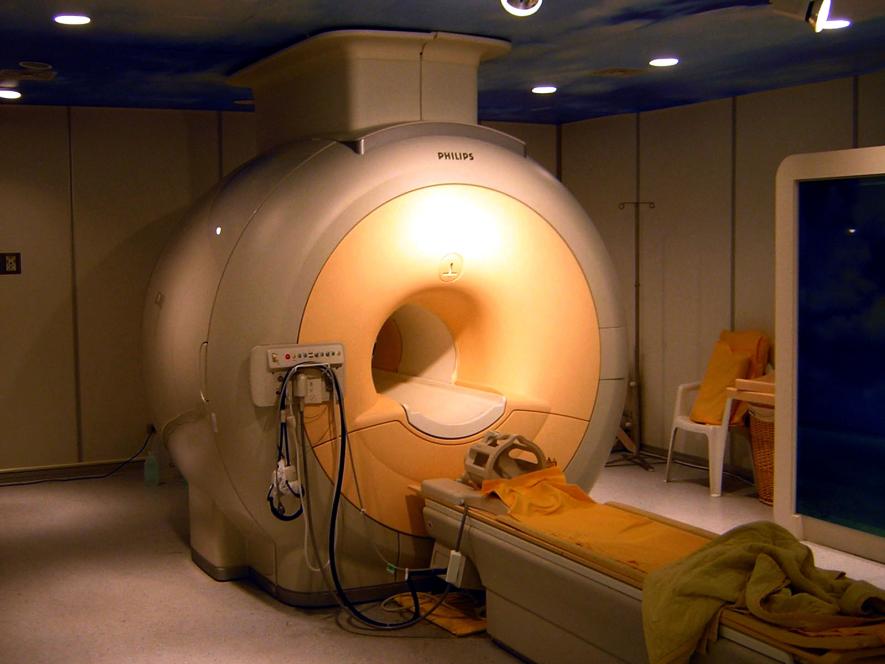Ultra-Low Field MRI Scanner Could Make Imaging Accessible

Image Courtesy: Wikimedia Commons
Imaging techniques have become an integrated part of diagnosis in today’s medical sciences. In many situations, a doctor will not diagnose without having a detailed scanning of the body. Yes, it is good to have prior detailed knowledge of any lesions, aberrations or fractures in a particular organ and even the exact locations in the affected organ before deciding on a medication realm or even surgery. Different imaging techniques like the MRI (Magnetic Resonance Imaging), CT (Computed Tomography) scan, PET (Positron Emission Tomography) etc., are used depending upon the nature of the disease and the organs involved.
However, even such an essential part of medical diagnosis remains inaccessible for most people in the world. For example, MRI, a unique tool for assessing brain injuries and disorders, is not accessible to about 70% of the world's population. The high field MRI machines are costly, going beyond a crore. Moreover, these machines demand high maintenance costs and installations as they need special infrastructure requirements. They need a specially designed room that can shield the MRI machine from outside signals and curb the powerful magnetic fields emanated from these machines. The MRI machines also need liquid helium cooling systems, which adds to their high cost of running.
An alternative to the pricey yet important medical technique can be low-cost and portable machines in such a backdrop. Researchers worldwide are focusing on it lately, and we get some hints of possibilities. In the latest research published in Nature Communication, a team from the University of Hong Kong has described an MRI scanner that needs no magnetic or radiofrequency shielding is acoustically quiet. It can draw power from a standard wall socket. This MRI machine will be of low manufacturing and operating costs which really can be helpful for low and middle-income countries.
The usual MRI machines use a very high-intensity magnetic field (1.5 Tesla or 3 Tesla) with the help of superconducting magnets. A superconducting material can be anything that exhibits a set of physical properties where electrical resistance vanishes combined with magnetic fields expelled. On the other hand, an ordinary metallic conductor has the property of resistance. To achieve superconductivity, a material has to be kept below a critical temperature where the resistance of the superconducting material becomes zero abruptly. The superconducting materials need a shallow temperature to cool them down (also to achieve the critical temperature). The MRI machines use liquid helium for this purpose. All these things make it a very high priced technique.
Recently, Hong Kong University has reported the possibility of low-cost MRIs based on ULF (Ultra-Low Field) magnetic field with an intensity much lesser than the usual ones (around 0.055 Tesla). The ULF design uses permanent magnets instead of lower intensities. They don't need a supercooling system like superconducting MRI machines with very high intensity.
However, the ULF machines also have a caveat: the resolution of images they take. The low-intensity magnets make the signals comparatively weaker, and the noise ratio in the signals are very high, producing images of inferior resolution.
But, Hong Kong University has developed a ULF MRI scanner that could detect brain lesions. The prototype ULF scanner could detect the most important pathologies among 25 patients with similar image quality as the 3 Tesla MRI scanners.
Ed Wu, the corresponding author of the new research, viewed that the new scanners are not designed as replacements of the existing high field MRI scanners but to complement them.
“With a field strength that is almost two orders of magnitude lower than the mainstream MRI, the image quality is inevitably less appealing simply due to the MR physics: lower field strength, weaker MR signal, less to play with,” Wu commented. "However, MR signals and physics have many appealing properties at ultralow-field, in terms of data acquisition and image formation”.
Wu further said—“ I believe that computing and big data will be an integral as well as an inevitable part of future MRI technology," Wu adds. "Given the inherently 3D, highly quantitative and ionization-free nature of MRI, I believe widely deployed MRI technologies will lead to immense opportunities in future data-driven MR image formation and diagnosis in healthcare. This will lead to low-cost, effective and more intelligent clinical MRI applications."
Get the latest reports & analysis with people's perspective on Protests, movements & deep analytical videos, discussions of the current affairs in your Telegram app. Subscribe to NewsClick's Telegram channel & get Real-Time updates on stories, as they get published on our website.
























